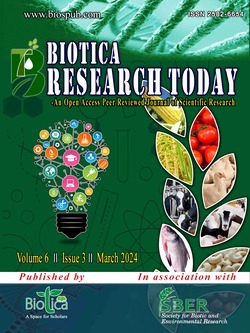
Production Technology of Blue Green Algae
Suraj Mishra*
Dept. of Soil Science and Agricultural Chemistry, College of Agriculture, Banda University of Agriculture and Technology (BUAT), Banda, Uttar Pradesh (210 001), India
Veerendra Kumar Patel
Dept. of Natural Resource Management, MGCGVV, Chitrakoot, Satna, Madhya Pradesh (485 334), India
Amar Singh Gaur
Jananayak Chandrashekhar University, Ballia, Uttar Pradesh (277 301), India
Shraddha Maurya
Dept. of Soil Science and Agricultural Chemistry, ANDUAT, Ayodhya, Uttar Pradesh (224 229), India
K.P. Pandey
Dept. of Agronomy, College of Agriculture, Banda University of Agriculture and Technology (BUAT), Banda, Uttar Pradesh (210 001), India
DOI: NIL
Keywords: BGA, Environment, Inorganic fertilizers, Nitrogen
Abstract
Blue-green algae (BGA) is a prokaryotic phototrophic organism capable of fixing nitrogen in the atmosphere and commonly used in agricultural fields for fertilizer, particularly in paddy fields. In addition to their ability to fix nitrogen, they are used with a variety of adsorbents to preserve soil fertility and other productivity-boosting soil components while also promoting crop growth. The current study demonstrated the various technologies used in the production of blue-green algae, its application and the impact of BGA on the growth and yield of paddy crops. Plants treated with inorganic fertilizers (N, P, K) produced lower yields and lowered growth attributes compared to the treatment (T4) combined with NPK+BGA. Under these circumstances, the grain and straw yield increased by 22.2% and 28.9%, respectively, compared to the control (T1).
Downloads
not found
Reference
Das, N.P., Kumar, A., Singh, P.K., 2015. Cyanobacteria, pesticides and rice interaction. Biodiversity and Conservation 24, 995-1005. DOI: https://doi.org/10.1007/s10531-015-0886-8.
Paudel, Y.P., Pradhan, S., Pant, B., Prasad, B.N., 2012. Role of blue green algae in rice productivity. Agriculture and Biology Journal of North America 3(8), 332-335. DOI: https://doi.org/10.5251/abjna.2012.3.8.332.335.
Singh, A.K., Singh, A.P., Gaurav, N., Srivastava, A., Gariya, H.S., 2016. Growth of BGA on different types of soil, effect of BGA on physical and chemical properties of soil for paddy plants. Journal of Medicinal Plants Studies 4(3), 111-114.
Thajuddin, N., Subramanian, G., 2005. Cyanobacterial biodiversity and potential applications in biotechnology. Current Science 89(1), 47-57. URL: https://www.jstor.org/stable/24110431.
